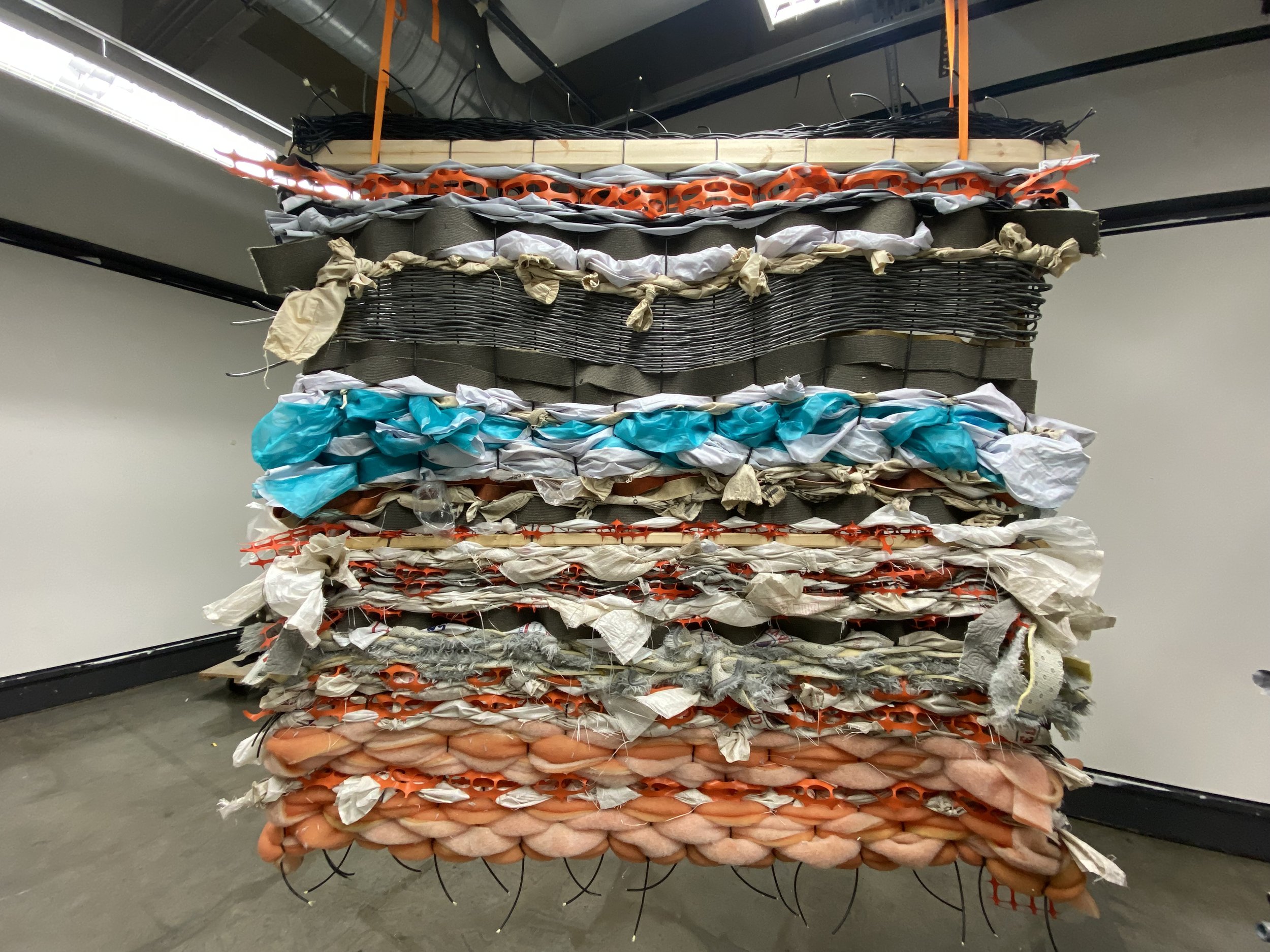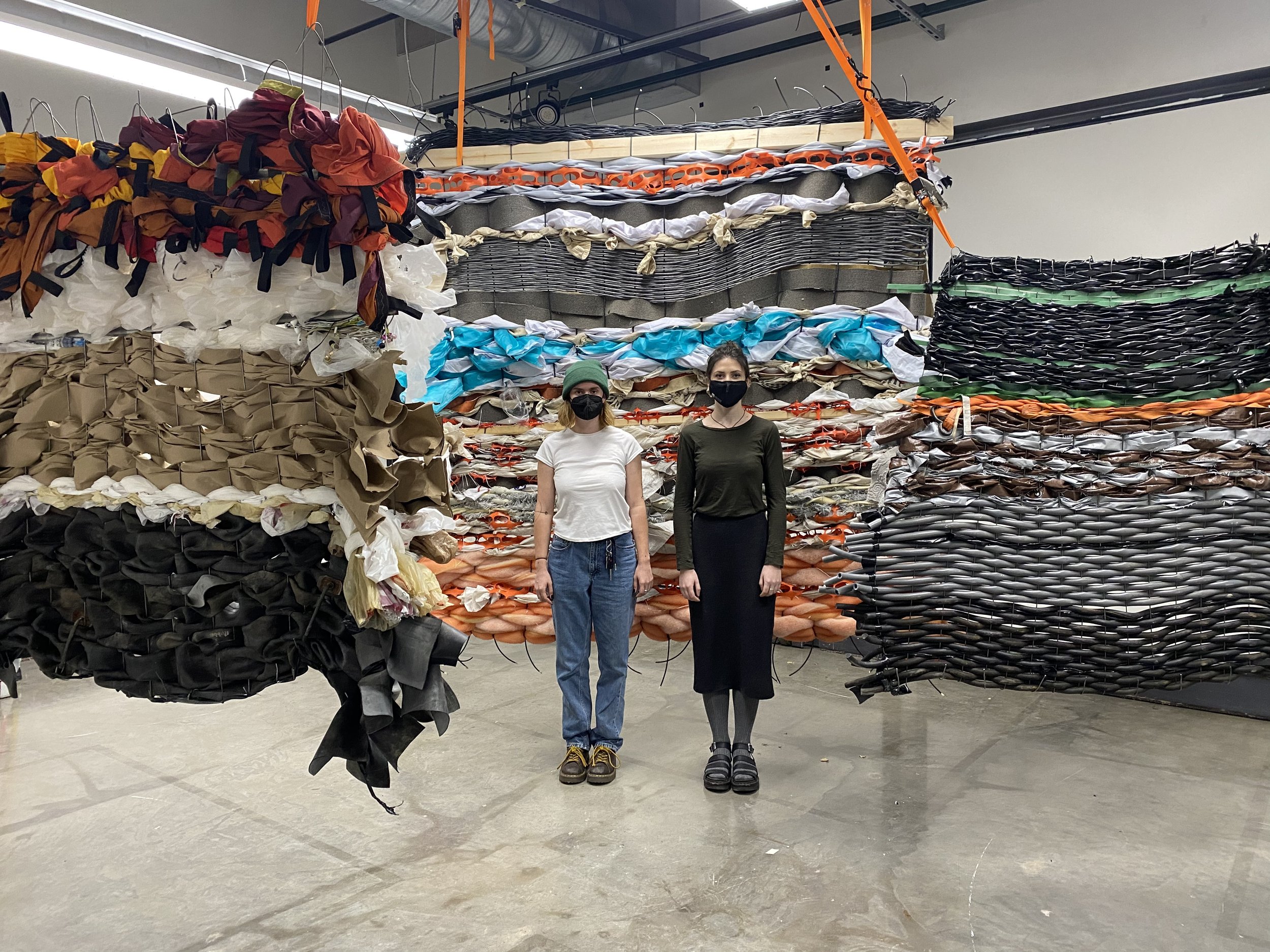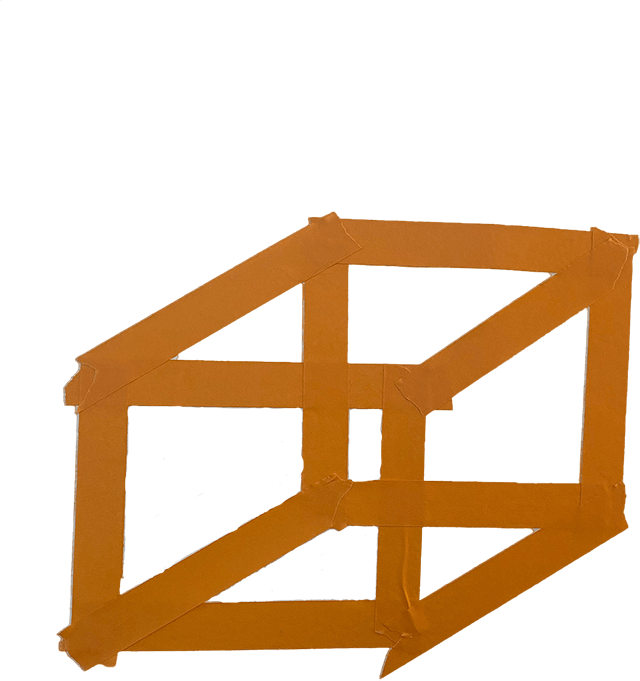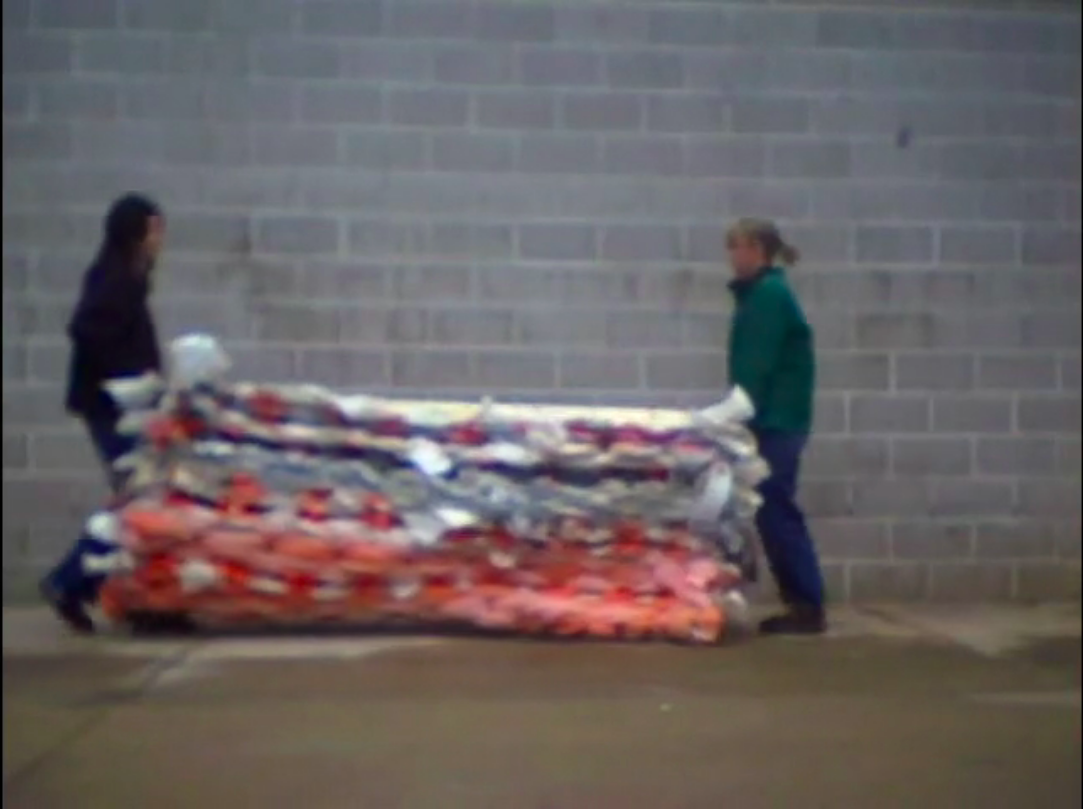Float me down the river beyond this indefinite existence (2022)
This installation was created in collaboration with Julia Reising and shown in the 2022 BFA Capstone exhibition Post- in the Katherine E. Nash Gallery at The University of Minnesota-Twin Cities.
On Process: Weaving
Approaching another work day I am tired, but continuing forward. More materials must be gathered and cut into strips. If not strips, scraps flexible enough to be woven
Over; under
Over; under
within the parameters of the weak frame. A roll of grey carpet is first to be deconstructed. I throw it on the ground and a noticeable cloud of dust follows it. Maybe the cloud is made up of dirt from shoe bottoms and dead skin. Layers of sediment accrued from years of the carpets life on a classroom floor flying into the air in front of me- gross
“The abject is not an ob-ject facing me, which I name or imagine” (Kristeva, 1).
When my scissors meet the carpet for the first time I am returned with resistance. There is a continuous loop of tension as I grudgingly force my way through the material. By the time one strip is finally freed my hand throbs. I acknowledge the pain momentarily, scoop up the material, and continue forward.
I approach the traffic cone next. Its orange coating is faded and pockmarked. A reminder of seasons past.
“Nor is it an ob-jest, an otherness ceaselessly fleeing in a systematic quest of desire” (Kristeva, 1).
Black soot covers my palms as I shift it around, searching for a method or place to begin cutting. Vertical strips of orange rubber will not stretch 10 feet. I start with the small opening at the top. The fabric scissors we have now chosen as our primary tool slide easily through the material- a stark contrast to the grey carpet that holds a solid vertical shape against the weight of other materials. I circle around the cone, cutting it into one long strip. The once bright white interior of the cone is now revealed. The deconstructed object is now unrecognizable.
“What is abject is not my correlative, which, providing me with someone or something else as support, would allow me to be more or less detached and autonomous” (Kristeva, 1).
The base of the cone stays in the studio, a perfect holding place for a basketball.
Can a basketball be woven?
I rub some soot off of my hands back onto the material, moving forward.
The frame, or loom, is now filled with layers of sediment. Standing at ten feet by ten feet, it is our largest yet.
“What has changed?”
“Scale has changed.”
The soreness in my hands is replaced with numbness in the November air. I am continuing forward. The strip of carpet finds its place in the layers of material. It slides easily through the vertical cables compared to its predecessors. The traffic cone twists and untwists as it moves into place with a similar fluidity. Snow fencing, blow-up pools, and long strings of canvas bags harboring gigantic knots do not move so fluidly. After several more layers of sediment find their way in the weaving, we inspect a piece of lumber.
What materials can not be woven?
Is the lumber woven if it does not bend?
The lumber finds its way. The skeletal chords of the loom wrap themselves easily around the material. We hang from the lumber by our fingertips, allowing our combined bodyweight to compress the layers beneath us. The space left above the lumber is daunting. The loom still harbors a large space for many more materials to find their places- the end of their functional lives. More snow fencing, carpet, woven bags, the pool, layers of neatly stacked chords, textile, and another piece of lumber will follow.
When it is time to cut the object away from its frame two people are needed to help move it. We only make it several feet before the lumber begins to crack at the corners. We drag the weaving and its semi-attached pieces across the courtyard and drop it to the ground. The physical effects of the process on our bodies settling in as we start to cut the object away from the fractured lumber, tying the loose ends of material. When it is settled next to the two previous works it becomes a resting place for my tired body before an object to seek meaning in. I collapse onto the stack of dejected materials. They comfort me.
“If the object, however, through its opposition, settles me within the fragile texture a desire for meaning, which, as a matter of fact, makes me ceaselessly and infinitely homologous to it, what is abject, on the contrary, the jettisoned object, is radically excluded and draws me toward the place_where meaning collapses” (Kristeva, 1).
On Collaboration
From the beginning, the ideas were one. Before an idea has the chance to fully leave my lips you speak it aloud.
“I was thinking…”
“...carpet next?”
Do we respond to the materials or each other?
I am constantly reminded of the physical necessity in our working relationship. From our respective halves of the loom, passing a heavy stacked circle of chord back and forth. At times, even the divided labor feels barely manageable. We balance precariously on the very top of ladders of mismatched heights, passing the chord
Over; under
Over; under.
Has an hour passed? Two?
This repetitive process is exhausting, and without you, impossible. The loom cannot be worked by only one body. The 10’ x 10’ structure requires two. So out of necessity “TenxTen” will become our name.
What brings us together more than a specific material sensibility or ideas themselves is mutual trust. When it makes sense for the physical labor to be divided exactly in half, it is. However, this is often unrealistic. Push and pull between us is constant.
“A commitment whereby someone delegates to someone else the totality of the attitudes and activities involved in the making of a work is incompatible with a commitment to authoring or co-authoring that work” (Livingston, 223).
But we never ruminate on this.
On Installation
Five by Five
Five by Five
Ten by Ten
Three weavings collapsed in front of us.
Three objects are now completed. They were a determined resting place for us and now, they are bodies slumped against the wall in the studio. Layers of sediment organized, now removed from their frames. The time-keeping log has grown.
Fiber optic cable Textile Rug Builder’s Paper
Carpet Plastic Pool Plastic Bags Headphones
Traffic cone Lumber Shower Curtain Charging Cords
Canvas Bags Snow Fencing Foundry Sand Parachute
Sheet Plastic Insulation Extension Cords Steel Wire
Rubber Gasket Garden Hose Ratchet Straps Tarp
Metal Straps Saw Blade Rubber Inner Tubes Screen Mesh
Plastic Tubing Canvas
Each sediment-forming material has been discarded, found, deconstructed, and cemented among its familiars. Each strip of material now exists in a space that is both familiar and entirely unrecognizable. We acknowledge that our weavings look and feel as tired as we are in their immediate state. So we decide we must hang them, honor them. Ten by Ten is first to be grudgingly peeled from the floor. Its physical weight is apparent as a third body comes to help us raise the object to the ceiling. Bright orange tension straps are our decided method to suspend each object. The straps are clean, fresh from the box even. Their newness is a stark contrast to the faded green and orange straps found in the first Five by Five. Years of use are contained in those.
Three completed weavings hang in front of us.
Three times now we have gathered dejected materials and arranged them using a process that traditionally honors beauty. The material's previous function was a previous life. Each material is now determined to be a corpse beginning an indefinite afterlife. Collectively, the three weavings form a graveyard. The ego ultimately separates the two possible lives of these materials. I (we) decide where the functional lives begin and end. We attach a new life through the physical acts of sorting, processing, and arranging the objects.
Deconstruct.
Reconstruct.
Kristeva, Julia “Powers of Horror: An Essay on Abjection”, 1982, pp. 1-2
The Journal of Aesthetics and Art Criticism, SPRING 2011, Vol. 69, No. 2 (SPRING
2011), pp. 221-225
Raft (2022)
(54” x 54” x 0.5”)
Expandable hose, bike tire, reinforced clear vinyl tubing, traffic cone, plumbing hose, orange extension cord, red textile, pink cable, black cable, air hose
experiment (2), 2021
video running time: 0:24
experiment (1), 2021
video running time: 2:24















